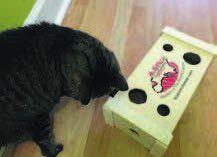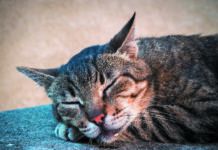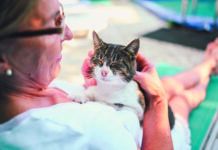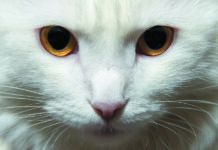© Ingrid Johnson
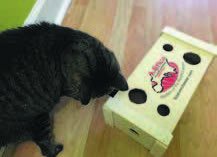

Two animal behaviorists and a veterinarian reporting in the Journal of Feline Medicine and Surgery have shown that feeding cats using food puzzles — either little balls with holes in them or gadgets that need to be manipulated by the cat to release food — can reverse a variety of psychosocial and physical problems. In a long list of examples, they describe obese cats that lost as much as 30 percent of their body weight by learning to eat from food puzzles. Food puzzles have also helped cats stop urine marking, biting, stealing food from peoples’ plates, vocalizing at night, or acting depressed or anxious.
What makes food puzzles work? Theories revolve around replicating your cat’s natural instincts by mimicking circumstances found in nature. Using a food puzzle can successfully combat the mental health problems and physical ailments that impact housebound cats. These simple devices compel cats to work to retrieve their food throughout the day rather than having it served up to them in a bowl.
The behaviorists aren’t surprised at the good outcomes. Food puzzles are known to work for animals like lions and tigers in zoos. Presenting foraging opportunities with the introduction of food puzzles cuts down on the stereotypical behavior of those caged cats, like pacing, and also improves or maintains good body condition. So why wouldn’t it work for smaller cats, who have the same drives, living in our homes?
The goal is to start gradually and work up to a point where your cat gets food only from puzzles as opposed to from bowls.
Acclimating your cat to food puzzles
There are two kinds of food puzzles. Some are shaped like balls or eggs that roll around as a cat pushes them with his paw or nose trying to get the food out. The others remain in one place and have sturdy bases. Both have holes or openings that dispense food the cat works to get out. You can buy food puzzles in a store or easily make them yourself by cutting holes in yogurt containers, toilet paper rolls, egg cartons, margarine tubs, or water bowls. Many of the commercial ones, as well as those that are homemade, can be popped in the dishwasher or easily washed in the sink.
Whether store bought, DIY, or a combination, you’ll want to try a variety of puzzles to see which type your pet enjoys, or if he enjoys several different kinds. Some cats may prefer rolling puzzles they push with their noses. Cats who like to work with their paws often like both movable and stationary puzzles. Either way, you’ll make progress faster by following these guidelines.
1|Start with easy puzzles with a number of openings to make it easier to obtain food. This type will have big holes or can be loaded to the brim. Some store-bought puzzles allow you to make the food holes bigger and then smaller, allowing the cat to start out by reaching the food with less difficulty and progressing to more demanding requirements for digging out what’s inside.
2|To introduce a food puzzle, make sure your cat is hungry. You want motivation to be high. You can increase motivation by starting with treats and switching to the cat’s regu-lar diet later.
3|If your cat likes wet food, go with stationery puzzles. Your pet will have to lick it out, mimicking the natural way cats use their jaw muscles to remove flesh from bone. Stationary puzzles are also quieter. Two of the commercially available stationary puzzles are the Catch by Northgate and the Tunnel Feeder by Trixie Pet.
You’re going to have to observe your cat for the best way to make the gradual switch from food in a bowl to food in puzzles, your ultimate aim. In most cases, you’ll want to start by putting some food in his regular bowl and some in a puzzle, shifting the balance to food puzzles as he gets used to them.
For more information about introducing food puzzles to cats, suggestions for brands to buy, and DIY versions to make, along with videos of cats getting the hang of it, two of the researchers, certified cat behavior consultants Dr. Mikel Delgado and Ingrid Johnson, have teamed up to create a clear, instructive website called foodpuzzlesforcats.com. It’s very easy to navigate and will make getting started a snap. Before long, you’ll have a thinner and happier cat who’s easier to get along with and enjoys the mental stimulation of foraging for his meals.
The Trouble with Cats
Obesity, aggression, urinating outside the box, late-night meowing, anxiety, pacing, social withdrawal: These constitute some but not all of the physical and behavioral problems experienced by many house cats. A number of behaviors can cause difficulties for owners, ranging from not being able to get a good night’s sleep to an inability to get near their pet because they scratch or bite. These cats are veritable scaredy cats, interfering with the human-animal bond. And physical problems caused by a sedentary lifestyle increase veterinary bills. Obesity paves the way for diabetes and musculoskeletal problems like joint pain.
It’s not surprising why so many cats are a bundle of neuroses and physical com-plaints. Most of our cats live entirely indoors. This practice (which Tufts recommends) keeps them safe but runs completely contrary to their natural instincts. Like their big-cat cousins, our pets are genetically hard-wired to roam their environment hunting for food. Natural predators, cats are born to go after multiple small meals over the course of a day.
Food puzzles are a great way to respect these natural instincts — giving him mental challenges while building his physical well-being.

